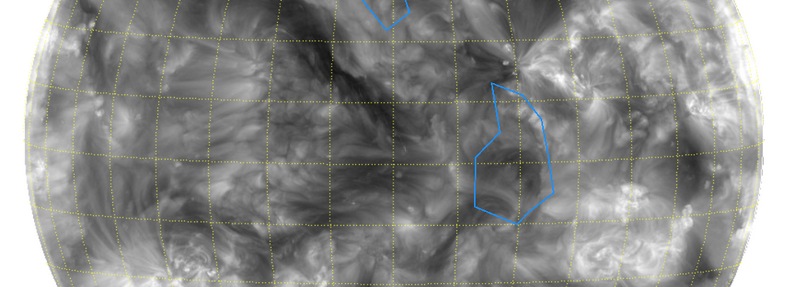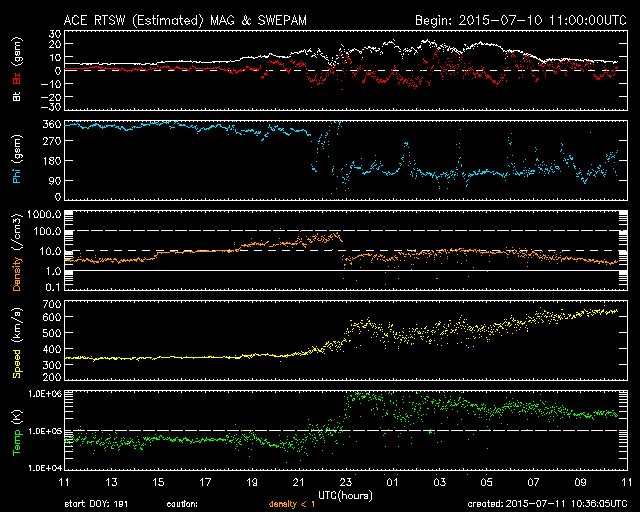Coronal hole high speed stream causing geomagnetic storming

During the late UTC hours of July 10, 2015, coronal hole high speed stream (CH HSS) hit Earth's magnetic field causing enhanced geomagnetic activity.
Geomagnetic K-index of 5 threshold (G1-Minor geomagnetic storm) was first reached at 22:44 UTC. Area of impact was primarily poleward of 60 degrees Geomagnetic Latitude.
Under G1 conditions, weak power grid fluctuations can occur, minor impact on satellite operations is possible. Aurora may be visible at high latitudes.
Geomagnetic activity might reach G2-Moderate levels during July 11 and return to quiet conditions by July 13.

Observed planetary KP index (average) by 10:30 UTC on July 11, 2015. Image credit: NOAA/SWPC.
In their Forecast Discussion issued 00:30 UTC on July 11, SPWC said solar wind parameters at the ACE spacecraft were representative of ambient background conditions until around 15:00 UTC on July 10. Solar wind parameters then became disrupted due to the onset of a co-rotating interaction region (CIR) ahead of a positive polarity coronal hole high speed stream (CH HSS).
Total field values increased from near 5 nT to as high as near 12 nT.
Solar wind velocities remained steady with an average of about 340-350 km/s.
The Bz component varied between north and south orientations and had a maximum negative deflection of -6 nT.
The phi angle continued in a primarily negative (towards the Sun) sector.
At approximately 22:45 UTC, the IMF total field increased to 19 nT, Bz dropped to -14 nT, wind speeds increased to over 520 km/s, and the Phi angle switched to a positive (away from the Sun) orientation, all in response to an increase in activity from the CIR.
A recurrent CH HSS preceded by a CIR is expected to disrupt the solar wind environment early July 11. Based on recurrence, CH HSS influences are expected to drive solar wind speed increases to near 600 km/s. Effects from the CH HSS are expected to continue July 12. By July 13, nominal conditions are expected to return as the CH HSS wanes.

Image credit: NOAA/SWPC.
Around 22:38 UTC on July 10, the geomagnetic field activity increased to active conditions, followed quickly by an increase to minor (G1-Minor) storm conditions as the anticipated CIR impacted Earth.
CIR and CH HSS influences are likely to produce periods of active to major (G2-Moderate) storm conditions early on July 11. Minor (G1-Minor) storm conditions are expected to continue through the first couple of periods on day one as CH HSS effects persist. Waning CH HSS effects are expected to persist into July 12, with active levels possible.
Geomagnetic field activity is forecast to return to quiet conditions as the CH HSS continues to wane on July 13.
Featured image: Detected coronal holes based on SDO AIA/193 on July 11, 2015 at 08:00 UTC.

Commenting rules and guidelines
We value the thoughts and opinions of our readers and welcome healthy discussions on our website. In order to maintain a respectful and positive community, we ask that all commenters follow these rules:
We reserve the right to remove any comments that violate these rules. By commenting on our website, you agree to abide by these guidelines. Thank you for helping to create a positive and welcoming environment for all.